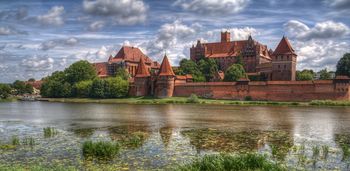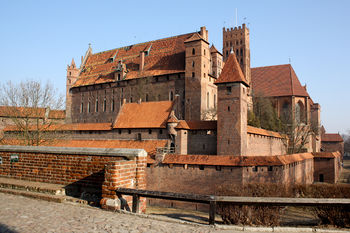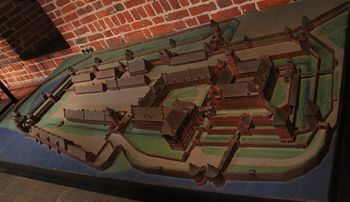Malbork Castle: Difference between revisions
imported>Richard Nevell (Redistribute images) |
imported>Richard Nevell No edit summary |
||
| Line 20: | Line 20: | ||
Once the Prussians were subjugated, the Teutonic Knights focussed their efforts on conquering pagan [[Lithuania]]. At the peak of their power, the Teutonic knights controlled about 120 castles and the Order's castles in Prussia formed the densest concentration of military buildings in all of Europe.<ref>Emery, Anthony (2012). "Castles of the Teutonic Knights: Malbork Castle" in Dan Snow (ed.) ''Battle Castles: 500 years of knights & siege warfare''. London: Harper Press. pp. 252–253. ISBN 978-0-00-745558-4.</ref> In 1386 the Grand Duke of Lithuania converted to Christianity.<ref>Emery, "Malbork Castle – Poland", pp. 142–143.</ref> This did not lead to peace with the Teutonic Knights, however, as the Order claimed the conversion was false. An alliance was brokered between Lithuania and Poland.<ref>Nicholson, Helen J. (2004). ''The Crusades''. Westport, CT: Greenwood Publishing Group. p. 51. ISBN 0-313-32685-1.</ref> | Once the Prussians were subjugated, the Teutonic Knights focussed their efforts on conquering pagan [[Lithuania]]. At the peak of their power, the Teutonic knights controlled about 120 castles and the Order's castles in Prussia formed the densest concentration of military buildings in all of Europe.<ref>Emery, Anthony (2012). "Castles of the Teutonic Knights: Malbork Castle" in Dan Snow (ed.) ''Battle Castles: 500 years of knights & siege warfare''. London: Harper Press. pp. 252–253. ISBN 978-0-00-745558-4.</ref> In 1386 the Grand Duke of Lithuania converted to Christianity.<ref>Emery, "Malbork Castle – Poland", pp. 142–143.</ref> This did not lead to peace with the Teutonic Knights, however, as the Order claimed the conversion was false. An alliance was brokered between Lithuania and Poland.<ref>Nicholson, Helen J. (2004). ''The Crusades''. Westport, CT: Greenwood Publishing Group. p. 51. ISBN 0-313-32685-1.</ref> | ||
As the Teutonic Knights refused to recognise Lithuania as a Christian state, the Polish–Lithuanian alliance began a campaign against the Order in 1410. The objective was to capture Malbork Castle as it was the headquarters of the Teutonic Knights. Polish and Lithuanian armies marched into the Order's borders with a combined force of 42,000 soldiers. On 15 July at the village of Tannenberg, some 60 miles south-east of Malbork Castle, the alliance faced the Teutonic Knights in pitched battle. The battle was in favour of the Teutonic Knights until their leader, the Grand Master who controlled the entire Order, was killed. The tide of battle turned against them as the Knights fell into disarray and retreated to Malbork Castle. While 9,000 died on the Polish and Lithuanian side, 14,000 of the army of the Teutonic Knights were taken captive and thousands more were dead.<ref>Emery, | As the Teutonic Knights refused to recognise Lithuania as a Christian state, the Polish–Lithuanian alliance began a campaign against the Order in 1410. The objective was to capture Malbork Castle as it was the headquarters of the Teutonic Knights. Polish and Lithuanian armies marched into the Order's borders with a combined force of 42,000 soldiers. On 15 July at the village of Tannenberg, some 60 miles south-east of Malbork Castle, the alliance faced the Teutonic Knights in pitched battle. The battle was in favour of the Teutonic Knights until their leader, the Grand Master who controlled the entire Order, was killed. The tide of battle turned against them as the Knights fell into disarray and retreated to Malbork Castle. While 9,000 died on the Polish and Lithuanian side, 14,000 of the army of the Teutonic Knights were taken captive and thousands more were dead.<ref>Emery, "Castles of the Teutonic Knights: Malbork Castle", pp. 272–277.</ref> | ||
In 1997 Malbork Castle was designated a World Heritage Site by UNESCO, recognising the importance of the site. It is named the "Castle of the Teutonic Order in Malbork".<ref>[http://whc.unesco.org/en/list/847 Castle of the Teutonic Order in Malbork], UNESCO, accessed 28 February 2013.</ref> | In 1997 Malbork Castle was designated a World Heritage Site by UNESCO, recognising the importance of the site. It is named the "Castle of the Teutonic Order in Malbork".<ref>[http://whc.unesco.org/en/list/847 Castle of the Teutonic Order in Malbork], UNESCO, accessed 28 February 2013.</ref> | ||
Revision as of 14:41, 12 March 2013

Malbork Castle was built from brick because suitable building stone was not available nearby.
Malbork Castle on the banks of the River Nogat in Poland was founded in the 13th century by the Order of Teutonic Knights.[1] From 1309 it was the headquarters of the Order. Occupying an area of 52 acres it is the largest brick-built castle in the world. Called Marienburg in the German language, the castle was named after the Virgin Mary. The castle was mostly complete by the 15th century.
History
The Order of the Teutonic Knights was by German knights who accompanied Frederick Barbarossa on the Third Crusade. The army disbanded after Barbarossa drowned. The Order was given papal recognition by Innocent III in 1199.[2] Though founded to protect Christians in the Near East, the Order turned its attention to eastern Europe and in 1226 attacked the pagan Prussians of eastern Europe near the Baltic Sea. The intention was to convert the Prussians to Christianity and protect the lands of the Christian Polish princes. The Order became so powerful that in 1283 the Kingdom of the Teutonic Knights was inaugurated.[3]

The Upper Castle (seen here from the south) was the earliest part of Malbork Castle to be built.
In the 1260s the Teutonic Knights were struggling to deal with a revolt. The Order had tried to secure their rule by building castles and establishing colonies, but many were attacked and captured, even the fortress of Marienwerder capitulated. The situation was so dire that Pope Urban IV diverted a crusade to the Baltic which he had originally intended to be sent against the Mongols. After Christian rule was reasserted the Teutonic Knights began reinforcing their key castles: Königsberg was rebuilt in stone, and Marienwerder in brick. It was in this context that the construction of Malbork Castle began in 1274. Emphasising the religious aspect of the castle's owners, it was named the Marienburg meaning "Mary's castle". Many castles built by the Teutonic Knights were named after the Virgin Mary, such as the Marienwerder and Marienburg.[4] This first building stage last until about 1300; at this point Malbork Castle consisted of what is now called the "Upper Castle" with an outer enclosure.[5]
The fall of Acre in 1291 meant that the Teutonic Knights no longer had to defend the Holy Land, so could concentrate their resources on the Batlic. When it became clear that the church would not call a crusade to recover the Holy Land, the Order's headquarters were moved from Venice (which would have been the disembarkation point for travel to the Near East) and established at Malbork in September 1309. At the time there were suggestions that all military orders should be dissolved. King Philip IV of France was a particularly strong proponent of this view and persecuted the Knights Templar within France. Malbork was chosen as the headquarters of the Teutonic Knights partly because it was beyond Philip's reach.[6] While the Order's Grand Master, Siegfried von Feuchtwangen was resident at Malbork Castle he undertook a programme of expansion, and the outer enclosure was redeveloped into the "Middle Castle". In the 1330s and 1340s work began on the "Outer Castle" and construction lasted for much of the 14th century.[7]
War with Poland and Lithuania
Once the Prussians were subjugated, the Teutonic Knights focussed their efforts on conquering pagan Lithuania. At the peak of their power, the Teutonic knights controlled about 120 castles and the Order's castles in Prussia formed the densest concentration of military buildings in all of Europe.[8] In 1386 the Grand Duke of Lithuania converted to Christianity.[9] This did not lead to peace with the Teutonic Knights, however, as the Order claimed the conversion was false. An alliance was brokered between Lithuania and Poland.[10]
As the Teutonic Knights refused to recognise Lithuania as a Christian state, the Polish–Lithuanian alliance began a campaign against the Order in 1410. The objective was to capture Malbork Castle as it was the headquarters of the Teutonic Knights. Polish and Lithuanian armies marched into the Order's borders with a combined force of 42,000 soldiers. On 15 July at the village of Tannenberg, some 60 miles south-east of Malbork Castle, the alliance faced the Teutonic Knights in pitched battle. The battle was in favour of the Teutonic Knights until their leader, the Grand Master who controlled the entire Order, was killed. The tide of battle turned against them as the Knights fell into disarray and retreated to Malbork Castle. While 9,000 died on the Polish and Lithuanian side, 14,000 of the army of the Teutonic Knights were taken captive and thousands more were dead.[11]
In 1997 Malbork Castle was designated a World Heritage Site by UNESCO, recognising the importance of the site. It is named the "Castle of the Teutonic Order in Malbork".[12]
Layout and architecture
Malbork Castle is mainly built from red brick. This was the case for many castles along the coast of the Baltic Sea as the region was poor in stone suitable for construction. Covering an area of 52 acres Malbork is the largest brick-built castle in the world.[5] The castle is divided into three enclosures: the Outer Castle, the Middle Castle, and the Upper Castle.[13]
References
- ↑ Emery, Anthony (2007). "Malbork Castle – Poland", The Castle Studies Group Journal 21. p. 139.
- ↑ Sterns, Indrikis (1985). "The Teutonic Knights in the Crusader States" in Kenneth Meyer Setton, Norman P. Zacour, and Harry W. Hazard (eds.), A History of the Crusades, Volume V: The Impact of the Crusades on the Near East. pp. 315–317. University of Wisconsin Press. ISBN 0-299-09140-6.
- ↑ Emery, "Malbork Castle – Poland", pp. 141–142.
- ↑ Christiansen, Eric (1997). The Northern Crusades, 2nd edition. London: Penguin Books. pp. 107–108, 222. ISBN 978-0140266535.
- ↑ 5.0 5.1 Emery, "Malbork Castle – Poland", p. 143.
- ↑ Christiansen, The Northern Crusades, pp. 150–151.
- ↑ Emery, "Malbork Castle – Poland", pp. 143–144.
- ↑ Emery, Anthony (2012). "Castles of the Teutonic Knights: Malbork Castle" in Dan Snow (ed.) Battle Castles: 500 years of knights & siege warfare. London: Harper Press. pp. 252–253. ISBN 978-0-00-745558-4.
- ↑ Emery, "Malbork Castle – Poland", pp. 142–143.
- ↑ Nicholson, Helen J. (2004). The Crusades. Westport, CT: Greenwood Publishing Group. p. 51. ISBN 0-313-32685-1.
- ↑ Emery, "Castles of the Teutonic Knights: Malbork Castle", pp. 272–277.
- ↑ Castle of the Teutonic Order in Malbork, UNESCO, accessed 28 February 2013.
- ↑ Emery, "Malbork Castle – Poland", p. 140.
